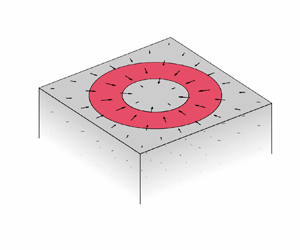Published online by Cambridge University Press: 02 September 2022

We re-examine the model proposed by Alexander et al. (Phys. Fluids, vol. 18, 2006, 062103) for the closing of a circular hole in a molecularly thin incompressible Langmuir film situated on a Stokesian subfluid. For simplicity their model assumes that the surface phase is inviscid which leads to the result that the cavity area decreases at a constant rate determined by the ratio of edge tension to subfluid viscosity. We reformulate the problem, allowing for a regularising monolayer viscosity. The viscosity-dependent corrections to the hole dynamics are analysed and found to be non-trivial, even when the monolayer viscosity is small; these corrections may explain the departure of experimental data from the theoretical prediction when the hole radius becomes comparable to the Saffman–Delbrück length. Through fitting, under these relaxed assumptions, we find the edge tension could be as much as six times larger ( $\sim$4.0 pN) than reported previously.
$\sim$4.0 pN) than reported previously.